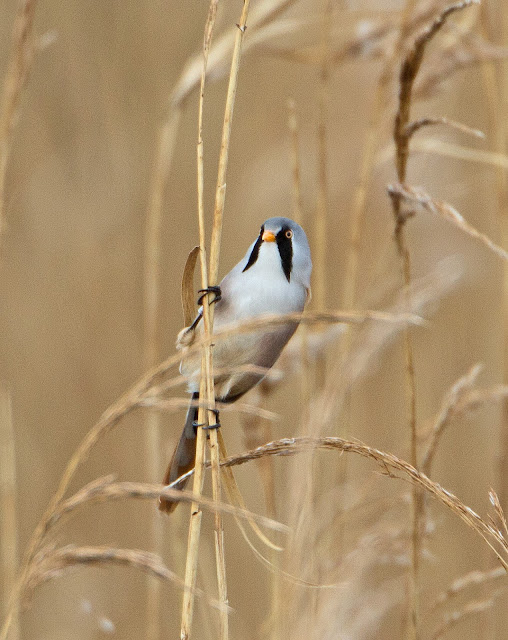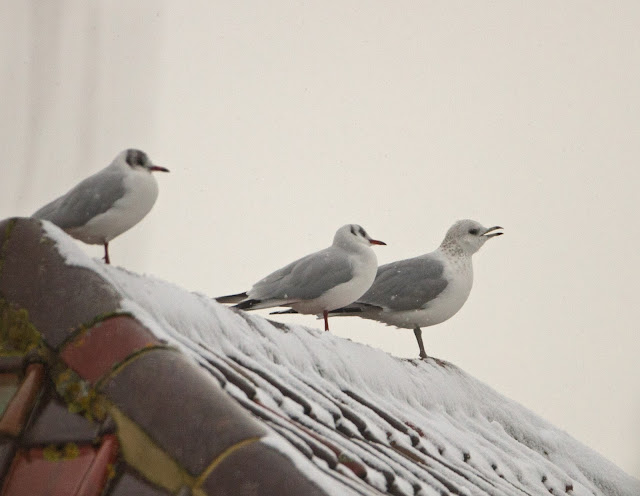We arrived at the ARC side of Dungeness at about 0800, no other cars were in the car park and we found the ARC hide to be empty and had it almost to ourselves for the next two hours - bliss! There was a sharp westerly breeze and I expected the birds to be sat in the lee of the hide - wrong! - the birds, mainly ducks were spread far and wide. First up was a distant fly by of a Marsh Harrier then another, then another. I reckoned on a least ten sightings, probably more. At one time we had four harriers in sight at the same time and another where three and a Buzzard were present, albeit at a distance. Next to arrive on the scene was a Great White Egret parading itself in front of the empty viewing screen, meanwhile an amorous Goldeneye was performing a fantastic display ritual to some uninterested ladies. Whilst all this was happening we had a flyby of a Kingfisher close to the hide windows, then Martin spotted a distant Bittern landing in the reeds of the far bank, the bird remaining in view at the edge of the reeds for some time.
I could hear a Cetti's Warbler calling in the reeds to the right of the hide and decided to investigate, opening the right hand side window I was amazed to see the bird foraging in the scrub immediately below the window. Talk about being frustrated, my lens far too big to get focus, for the first time I was asking a bird to move away. Anyway what usable shots I managed to get are shown below.
An eccentric head throwing display that didn't do a lot for the two females watching.
Having had more Kingfisher, Sparrowhawk, Marsh Harrier flybys and yet another Bittern we left the hide for the car park. On the trail a birder just in front of us flushed both the GWE and a Bittern from adjacent pools. Next port of call was Boulderwall Farm, just over the road, home to the most famous flock of Tree Sparrows in Kent. I had guaranteed Martin close up shots of them on the feeders by the farmhouse. To my amazement not a bird to be seen and my credibility out of the window, then slowly, two or three at a time the birds began arriving from a bush across the road. They seemed to put off by the strong breeze but eventually they showed.
The GWE or should I say 'a' as there are 7 of them reported to be in the area, flew by and landed in the pool next to the road. So, leaving Martin with the sparrows, I nipped onto the road and managed a record shot.
 |
| Why do Bitterns always crash land? |
 |
| A really smart bird |
A quick call in at the Visitor Centre and then away to Scotney Pit where there were monstrous amounts of wildfowl, all viewable from the comfort of the car. Despite much searching we found no hidden rarities, though we did get a Ruff roosting on the bank with three Redshanks. Before we left, a flock of Barnacle Geese, probably more than 30, arrived and landed on the grass. These are the usual residents and in with the flock were three Emperor x Barnacle hybrids that I had seen last year. On the far bank we spied yet another Marsh Harrier, they seem to be everywhere.
Making our way back to Eastbourne we paused at the "Colonel Body Memorial Lakes" at Pett Level, similarly filled with large amounts of wildfowl, oddly enough the Shoveler were more numerous than at Scotney. Oh and a Marsh Harrier quartering the far bank.
The Bonaparte's Gull at Princes Park had been reported as being present during the morning, but of course during our vigil it didn't show
So there you have it - a paradox - great birding - poor photography. The true measure of the day is that when Martin dropped me off at home I thought "What a great day - when are we going again?


















































